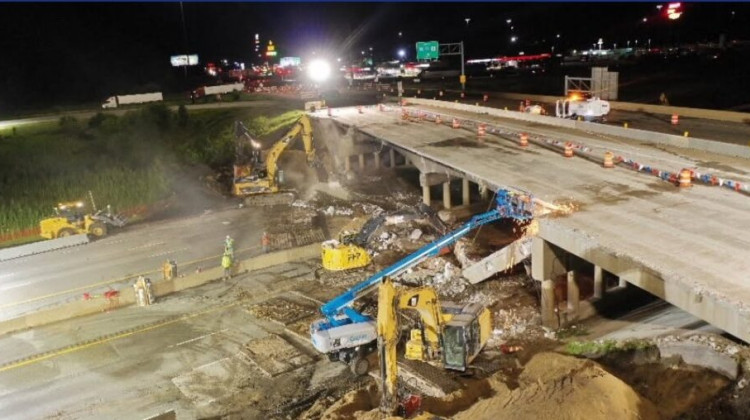
An orange substance coming from one of the outfalls at U.S. Steel's facility in Portage.
Courtesy of Collin CzilliUpdated Oct. 5 at 2:47 p.m.
An unknown orange substance from the U.S. Steel plant in Portage was found leaking into a Lake Michigan tributary on Sunday evening. State and federal environmental agencies are working with U.S. Steel to investigate the cause of the leak and find out if it's harmful.
This comes just weeks after U.S. Steel agreed to pay for a massive chemical spill at the plant four years ago.
Barbara Lusco is the harbor master for the Sammie L. Maletta Public Marina. She said over the course of a few hours, she watched the leak cover Burns Waterway.
"It was heading out onto Lake Michigan and it was slowly traveling southbound on Burns Waterway. It was a rusty, kind of a thick substance," Lusco said.
Lusco said she can’t see the leak at the marina anymore, but the marina has closed its ramp to protect the public. She said spills on Lake Michigan affect the public's enjoyment of the marina all too often.
U.S. Steel’s Portage plant was temporarily shut down because of the leak, but was running again as of Sept. 29. Indiana Dunes National Park also closed its beaches to swimmers and Indiana American Water shut off its intake at Ogden Dunes. As of Oct. 5, the beaches are now open and IAW is now up-taking water at Ogden Dunes again.
In 2017, U.S. Steel’s Portage facility spilled 300 pounds of the cancer-causing chemical hexavalent chromium into the Burns Waterway. Since then, the plant has had at least seven other water violations. Earlier this month the company agreed to pay more than $1 million for the 2017 spill.
U.S. Steel will also have to spend another $600,000 over the next three years testing Lake Michigan waterways for pollution.
Join the conversation and sign up for the Indiana Two-Way. Text "Indiana" to 73224. Your comments and questions in response to our weekly text help us find the answers you need on statewide issues.
Portage City Council President Collin Czilli said any leak or spill along the lake threatens residents’ drinking water and their livelihoods.
“It’s very frustrating that this continually happens and our hands as a city are tied," he said.
Czilli said only the Environmental Protection Agency and Indiana Department of Environmental Management can make sure U.S. Steel complies with its permit. That is, unless the city decides to take the company to court like the city of Chicago and the Surfrider Foundation did.
A spokesperson for U.S. Steel released the following email statement on Monday, Sept. 27:
“U. S. Steel shut down operations at its Midwest Plant as a precaution after experiencing an upset condition with the finishing line wastewater treatment plant. The plant operations will remain down until the condition is stabilized. This upset is currently believed to be the cause of the discolored water seen coming from one of our outfalls. Early indications show higher than normal suspended solids in the water, and we are conducting additional sampling and an investigation to determine the cause. U.S. Steel made all appropriate notifications to regulatory agencies and some officials have been onsite, including the U.S. Environmental Protection Agency, the Indiana Department of Environmental Management, the U.S. Coast Guard, and Porter County. We will continue to work with regulators and the community and will provide additional updates as they become available.”
On Tuesday, U.S. Steel issued a statement which said its preliminary test results showed the company didn’t discharge higher concentrations of chemicals than what it’s allowed by its permit, but that there was more iron in the wastewater — which explains the rusty color. The EPA and IDEM haven’t responded with their own test results.
The EPA issued its own statement Wednesday, echoing similar results. The federal agency said the water samples "do not indicate any health risks for people who may come into direct contact with the water along the Portage River Walk."
It also said federal and state agencies are continuing their investigation into discharge.
This story has been updated with comments from U.S. Steel and the U.S. Environmental Protection Agency. It has been updated again to reflect the reopening of the Indiana Dunes National Park beaches and IAW up-taking water from Ogden Dunes once more.
Contact reporter Rebecca at rthiele@iu.edu or follow her on Twitter at @beckythiele.
Indiana Environmental reporting is supported by the Environmental Resilience Institute, an Indiana University Grand Challenge project developing Indiana-specific projections and informed responses to problems of environmental change.
 DONATE
DONATE






 Support WFYI. We can't do it without you.
Support WFYI. We can't do it without you.